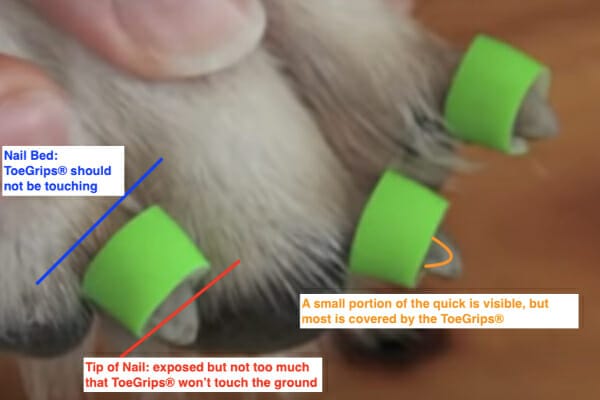Ensure the ToeGrips are positioned correctly on the nail
When you apply ToeGrips, they should fit securely around the toenail, but expose the tip of the nail. Depending on the length of your dog’s quick, most of the quick should not be visible once the ToeGrips are in place. In order for the ToeGrips to be effective, they should make contact with the floor when your dog is standing still. This creates the GripZoneTM, which is what helps them provide traction for your dog. If the ToeGrips are not contacting the floor, double check the size, position, or if your dog’s nails need trimmed.
It is also important that the ToeGrips are not be touching the nail bed (i.e. where the toenail attaches to the paw.) Frequently inspect your dog’s ToeGrips to ensure they haven’t worked their way up the nail over time. Having the ToeGrips in the proper zone on the nail helps ensure that they reach their full potential to help your dog.
To learn more about ToeGrips application, safety, and other related topics, check out the ToeGrips FAQs on our website or talk to a customer care member. Your veterinarian also can be a good resource if he or she is familiar with using ToeGrips.

Make nail trimming part of your regular routine
When you are starting out, you may only be able to cut a few nails at a time before you and your dog are ready for a break. Just jot down which ones you clipped and then start with different nails at the next trimming session. Over time, your dog will get used to the idea and you can trim all the nails in one session.
Also, some dogs with long nails also have long quicks. This means you may not initially be able to trim the nails as short as you would like. But as you continue to regularly trim your dog’s nails, the quicks will recede some and you will be able to get them shorter.
If you make nail trimming a normal part of your dog’s healthcare routine, his or her nails can stay short and healthy. Plus, it will soon seem like no big deal to you or your dog to trim the nails.
This is just a quick overview of nail trimming. However, there are many resources that can help provide more direction and detail including these three:
Your Dog Slides on the Floor
If your dog is sliding on the floor, his nails are probably causing a lot of instability. This usually happens when the nails are extremely overgrown, and his paw is not touching the ground for him to grip. His instability and sliding can lead to other injuries such as a joint luxation or a hairline fracture.
If your dog seems to be walking gingerly or limping, check to see if his nails are at the appropriate length. He may be in pain and is favoring one leg over another.
How to Trim Your Dog’s Nails at Home STEP BY STEP WITH TIPS
Nail care is an often overlooked aspect of our pet’s healthcare. But nail trims are just as important as any other part of a dog’s overall care regimen. However, figuring out when it’s time to trim your dog’s nails might not be super intuitive.
You might notice your dog’s nails are too long when they scratch you or when they begin to get caught on the furniture, but there are other signs that it’s time to get out the clippers or head to the groomer.
Paying attention to your dog’s nails and keeping them at an appropriate length can save you and your dog the pain of dealing with overgrown nails.